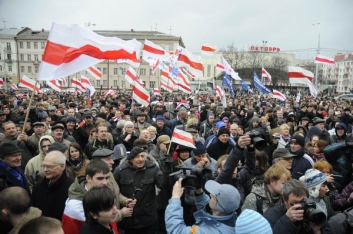Belarusian opposition comes up with new strategy: negotiations with authorities due to protest pressure
 The situation has not changed
The situation has not changed

Belarusian civil society has started working on a long term strategy of power change in Belarus based on previous attempts to change the Belarusian leadership through so-called “colour revolutions”. The new strategy is likely to depart from the revolutionary approach to power change and focus on evolutionary approach, by changing relations between the authorities and the opposition through negotiations, backed by mass street pressure. Yet there is neither unity in the opposition nor proper cooperation between the potential “negotiators” with the authorities and “revolutionaries” who support street activity.
Politicians, participants and leaders of the mass demonstration to protest against the rigged presidential elections in 2006 discussed the lessons of “The Square-2006” in Minsk last week.
Following several unsuccessful attempts in the 2000s, the ‘revolutionary’ scenario of power change in Belarus through mass protests on the election day, has lost its relevance. In addition, the harsh clamp down on protesters against rigged elections in 2010, followed by prosecutions of opposition leaders and activists has provoked a conceptual crisis in the Belarusian civil society.
Amid bloody events on the Kyiv Maidan in 2014, followed by Russian invasion, the annexation of Crimea and military action in the eastern Ukraine, the popularity of mass protests as a mean to change power in Belarus has reduced drastically.
The opposition leaders and activists and the opposition electorate have revised their views on the possibility of changing power in Belarus through street activity. In the 2015 elections, virtually all participants in the presidential campaign avoided the “revolutionary” rhetoric and calls for a change of power through protests.
Nevertheless, the authorities still do not regard the opposition as an equal partner in negotiations. For instance, despite high level of voter support for presidential candidate Tatsiana Karatkevich in the 2015 elections – according to independent polls circa 15.7%, – the authorities’ official data awarded her with only 4.44% of voter support.
That said, “Tell the Truth” campaign and former candidate T. Karatkevich now emphasise the need for a combination of both approaches in the opposition activity and propose that ‘negotiators’ coordinated their activities with ‘revolutionaries’ supporting street pressure in order to prompt the government to negotiations.
Meanwhile, street activity is rather unpopular in Belarusian society, in particular after futile protests of entrepreneurs. Despite the authorities’ relatively mild reaction, former political prisoner Nikolai Statkevich and his counterparts’ attempts to initiate mass street protest activity were unsuccessful and their street actions gathered few participants both, during and after the presidential campaign.
However, in the wake of the 10th anniversary of the so-called Ploshcha-2006, the attempt of a ‘colour revolution’ in 2006, which was the most successful and, hence, later romanticized, has returned to the oppositional discourse. In many ways, the Belarusian civil society has started perceiving the 2006 events as a kind of a standard of confrontation with the authorities.
In addition, independent media outlets have started rethinking with a touch of nostalgia the mass protests in the mid-1990s. Apparently, demand for street activity is beginning to emerge in Belarusian society, especially in the view of milder treatment by the authorities of the unauthorized opposition activity.
Overall, the Belarusian opposition has softened its rhetoric about regime change in the country. However, the Belarusian civil society is beginning to understand that both tactics could be used in the longer-term strategy: negotiations with the authorities in order to encourage them to reform the existing socio-economic and political model and mass street activity in order to demonstrate the society’s demand for an alternative.
Subscribe to our newsletter




Situation in Belarus
Constitutional referendum: main consequences


 Video
Video
How to count the political prisoners: are the new criteria needed?


 Video
Video
Paternalism In Decline, Belarusian Euroscepticism, And The Influence Of Russia


 Video
Video











